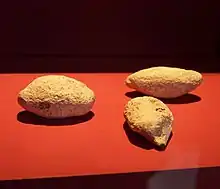Tony Clunn
John Anthony Spencer "Tony" Clunn MBE (10 May 1946 – 3 August 2014) was a retired major in the British Army, and an amateur archaeologist who discovered the main site of the Battle of the Teutoburg Forest at Kalkriese Hill.
Army career
Born in Kent, Clunn served in the ranks of the Royal Tank Regiment, rising to the rank of warrant officer class 1. He was then commissioned into the administrative section of the Royal Army Medical Corps as a lieutenant on 2 January 1986. His commission was backdated, with seniority as a second lieutenant from 2 July 1981, and as lieutenant from 2 July 1983.[1] He was promoted captain on 2 January 1988.[2] He was promoted major on 30 September 1994, having previously held the rank on an acting basis.[3] Appointed Member of the Order of the British Empire in the 1996 New Year Honours,[4][5] he retired from the army on 4 April 1996.[6]
Archaeology

Clunn searched for Roman coins with a metal detector as a hobby. In 1987, when he was attached to the Royal Tank Regiment in Osnabrück, he asked Wolfgang Schlüter, at the time the archaeologist for the District of Osnabrück,[8] where he should look.[9] He was advised to search 20 km north of the city, where Roman coins had previously been found,[10] though none for 18 years.
Schlüter's recommendation was based upon a study of maps and the 19th-century historian Theodor Mommsen's proposal that the Kalkriese area was a likely location of the battle which took place in 9 C.E.[11] On his first day, Clunn found several coins from the reign of Augustus, mostly in excellent condition.[9] No coins found at the site post-date 9 C.E.[12] He also discovered Roman sling shot in the vicinity of Kalkriese,[9] the first indisputable evidence of military activity there.[12][13] Previously there had been many conflicting theories about the location of the battle, and scholars had searched for it without success for 600 years.[10][14][15][16]
On the basis of Clunn's findings, Schlüter began a comprehensive excavation of the site in 1989,[8][10] later directed by Susanne Wilbers-Rost.[9][12] His finds are now displayed at the Varusschlacht (Varus Battle) Museum and Park Kalkriese, opened in 2002.[9][12] In the following years, Clunn investigated the entire area around Kalkriese. The coins he discovered have made it possible to reconstruct the route taken by the Roman legionaries under Varus and to determine where they were ambushed and massacred. In Clunn's opinion, the march route corresponds exactly to the changing environment as described by Dio Cassius.[17]
Retirement
Clunn returned to Osnabrück to live.[18] He was awarded the Cross of the Federal Republic of Germany. He died on 3 August 2014 at his home in Bissendorf.[19]
Publications
References
- "No. 50420". The London Gazette (Supplement). 3 February 1986. p. 1625.
- "No. 51194". The London Gazette (Supplement). 11 January 1988. p. 306.
- "No. 53807". The London Gazette (Supplement). 3 October 1994. p. 13871.
- "No. 54255". The London Gazette (Supplement). 29 December 1995. p. 6.
- "The New Year Honours: The Prime Minister's List", The Independent 30 December 1995.
- "No. 54378". The London Gazette (Supplement). 22 April 1996. p. 5716.
- Wolfgang Schlüter: Zwischen Lutherdamm und Oberesch – Die Anfänge des Kalkriese-Projektes. In: Varus-Gesellschaft (Hrsg.): Varus-Kurier. Georgsmarienhütte, April 2002. S. 7ff. (in German)
- Archäologie, Ausgrabung und Wissenschaft, Museum und Park Kalkriese, retrieved 7 September 2010. (in German)
- Fergus M. Bordewich, "The Ambush that Changed History", Smithsonian September 2005, pp. 3,–4.
- Peter S. Wells, The Battle That Stopped Rome: Emperor Augustus, Arminius, and the Slaughter of the Legions in the Teutoburg Forest, New York: Norton, 2003, ISBN 0-393-02028-2, p. 46.
- Theodor Mommsen, "Die Örtlichkeit der Varusschlacht", Berlin: Weidmann, 1885. (in German)
- David Crossland, "Battle of the Teutoburg Forest: Germany Recalls Myth That Created the Nation", Der Spiegel 28 August 2009.
- Wolfgang Schlüter with Frank Berger, Kalkriese – Römer im Osnabrücker Land: archäologische Forschungen zur Varusschlacht, Bramsche: Rasch, 1993, ISBN 3-922469-76-0, p. 20. (in German)
- "Fiasko in der Senke: Rekonstruktion der Varus-Schlacht auf der Basis der neuesten Grabungsfunde", Der Spiegel 28 October 1996. (in German)
- Kevin Sweeney, "Scholars look at factors surrounding Hermann’s victory" Archived 14 July 2011 at the Wayback Machine, The Journal, New Ulm, Minnesota, 20 September 2009, retrieved 7 September 2010.
- Pat Southern, The Roman Army: A Social and Institutional History, Santa Barbara: ABC-CLIO, 2006, ISBN 1-85109-730-9, p. 307.
- Tony Clunn, ed. Anna Cheeseman-Clunn and Ursula Cheeseman, In Quest of the Lost Legions: The Varusschlacht, London: Minerva, 1999; ISBN 0-7541-1068-0, p. 154.
- "Society for German-American Studies Symposium Held in Grand Rapids, MI", Steuben News, July/August 2005 Archived 28 July 2011 at the Wayback Machine, retrieved 7 September 2010. Clunn was the keynote speaker.
- "Varusschlacht-Pionier Tony Clunn verstorben", NDR, 7 August 2014 (in German)
Sources
- The Lost Legions of Varus. Television movie. Secret History Series 9. Granada Television, 2001. ImdB
- Wolfgang Schlüter. "Kalkriese: Ort der Varusschlacht. Die Ausgrabungen in der Kalkrieser-Niederwedder Senke". Archäologische Mitteilungen aus Nordwestdeutschland Beiheft 9 (1994). (in German)
